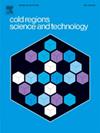疏冰材料评估的新见解:人体运动启发自动仪器(HMA)介绍
IF 3.8
2区 工程技术
Q1 ENGINEERING, CIVIL
引用次数: 0
摘要
冬季对裸露结构和运输的影响给各行各业,尤其是运输业带来了巨大的危险和成本。目前正在开发疏冰表面,以减少与冬季有关的影响。创建此类表面需要考虑各种因素,包括减少和防止冰的积累、显著降低冰的附着力和/或延迟水的凝固。虽然已有离心力和推脱试验等测量冰附着力的成熟方法,但其结果并不总是相关联,也不能提供特定应用所需的信息。为了更好地评估憎冰特性,我们开发了一种名为 "人体运动启发自动装置(HMA)"的新型装置,该装置可模仿刮冰模式下的人工除冰。HMA 的主要目的是模拟人类清除冰雪覆盖表面的过程,根据除冰的难易程度对疏冰特性进行更真实的评估。该仪器旨在通过提高测试的准确性、可重复性和多功能性,彻底改变疏冰材料评估方法。我们利用传统方法难以评估的低结冰条件开发了一种独特的程序,并对四种表面进行了评估:作为参照的铝、环氧基亲水涂层、疏水性硅弹性体涂层和疏水性环氧硅涂层。我们的 HMA 根据几个关键参数对表面进行表征,包括启动刮冰去除所需的法向力、达到的最大力、攻击角度和等效力,所有这些参数都与人类进行的验证测试一致。在所评估的表面中,硅树脂涂层所需的法向力最小,环氧硅树脂涂层的最大力和等效应力最小。我们的 HMA 结果与人类进行的验证测试非常吻合。HMA 可以评估各种关键结冰条件,有望在研发领域得到广泛应用。本文章由计算机程序翻译,如有差异,请以英文原文为准。
New insights into icephobic material assessment: Introducing the human motion–inspired automated apparatus (HMA)
The impact of winter on exposed structures and transportation poses significant dangers and costs to various industries, particularly the transportation sector. Icephobic surfaces are currently being developed to reduce winter-related impacts. Creating such surfaces requires considering various factors, including reducing and preventing ice accumulation, significantly decreasing ice adhesion, and/or delaying water solidification. Although established methods such as centrifugal force and push-off tests exist for measuring ice adhesion, the results may not always correlate or offer the needed information for specific applications. To better assess icephobic properties, we have developed a novel device called the human motion–inspired automated apparatus (HMA) that mimics manual de-icing performed by humans in a scraping mode. The primary objective of the HMA is to emulate human removal of ice-covered surfaces, providing a more realistic evaluation of icephobic properties according to the ease of ice removal. This apparatus aims to revolutionize icephobic material assessment by offering improved accuracy, repeatability, and versatility in testing. We developed a unique procedure using low icing conditions, which are challenging to evaluate using conventional methods, and assessed four surfaces: aluminum as a reference, an epoxy-based hydrophilic coating, a hydrophobic silicone elastomer coating, and a hydrophobic epoxy–silicone coating. Our HMA characterizes surfaces according to several crucial parameters, including the normal force required to initiate ice scraping removal, the maximum force achieved, the angle of attack, and the equivalent force, all consistent with validation tests conducted by humans. Among the evaluated surfaces, the silicone coating required the lowest normal force, and the epoxy–silicone coating had the lowest maximum and equivalent forces. Our HMA results align well with validation tests conducted by humans. The HMA enables evaluating various critical icing conditions and promises a broad range of applications in research and development.
求助全文
通过发布文献求助,成功后即可免费获取论文全文。
去求助
来源期刊

Cold Regions Science and Technology
工程技术-地球科学综合
CiteScore
7.40
自引率
12.20%
发文量
209
审稿时长
4.9 months
期刊介绍:
Cold Regions Science and Technology is an international journal dealing with the science and technical problems of cold environments in both the polar regions and more temperate locations. It includes fundamental aspects of cryospheric sciences which have applications for cold regions problems as well as engineering topics which relate to the cryosphere.
Emphasis is given to applied science with broad coverage of the physical and mechanical aspects of ice (including glaciers and sea ice), snow and snow avalanches, ice-water systems, ice-bonded soils and permafrost.
Relevant aspects of Earth science, materials science, offshore and river ice engineering are also of primary interest. These include icing of ships and structures as well as trafficability in cold environments. Technological advances for cold regions in research, development, and engineering practice are relevant to the journal. Theoretical papers must include a detailed discussion of the potential application of the theory to address cold regions problems. The journal serves a wide range of specialists, providing a medium for interdisciplinary communication and a convenient source of reference.
 求助内容:
求助内容: 应助结果提醒方式:
应助结果提醒方式:


